Whether you’re celebrating a birthday, special anniversary, or Valentine’s Day, this show stopping Vegan Vanilla Layer Cake with Raspberry Jam will not disappoint!
This is one of my new favorite cakes, and I am not exaggerating. The texture is moist and tender (and I didn’t even use cake flour!), the flavors are sweet yet tart and tangy so it’s not overpoweringly sweet like some cakes, and of course, it’s so pretty!
It might seem intimidating to assemble this kind of vegan layer cake, but once you’ve done it a few times, it’s actually pretty straightforward. In the event you’ve never made a layer cake, the blog contains detailed instructions and tips to help walk you through the process!
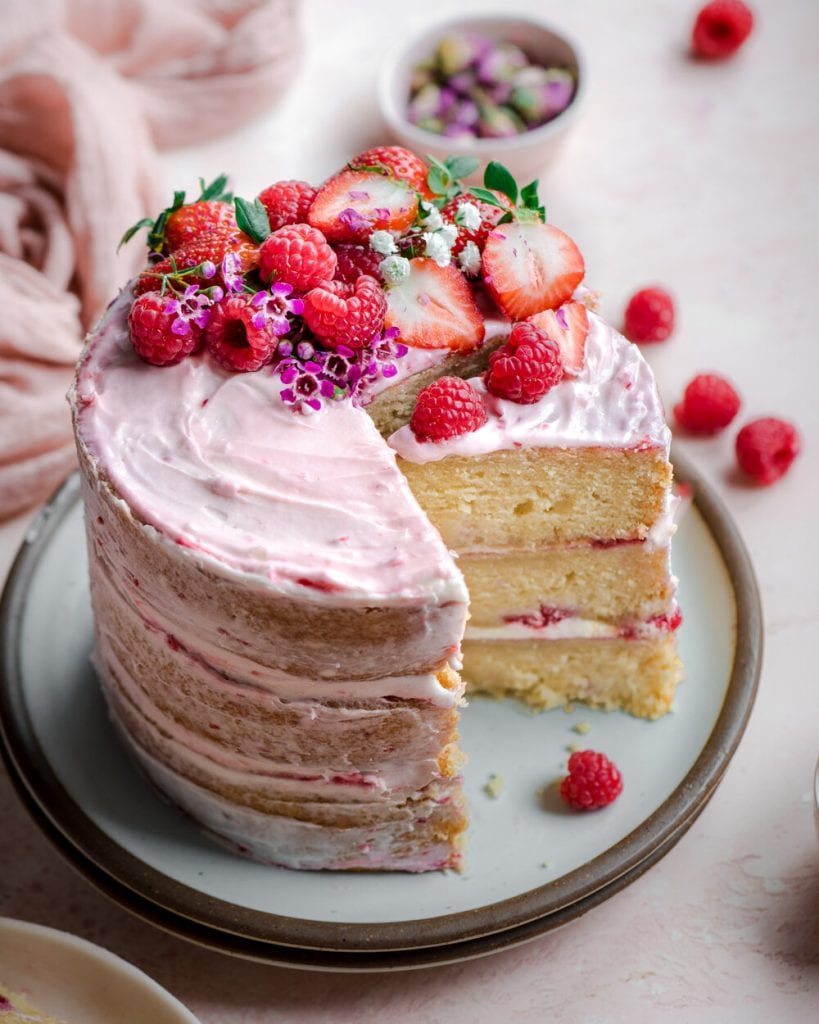
How to Bake a Vegan Layer Cake
Equipment needed for baking a vegan layer cake
Cake pans. You’ll need three 6-inch cake pans, or two 8-inch cake pans to bake this particular cake.
Parchment Paper. You’ll need some parchment paper to line the bottom of each cake pan. This ensures you can easily invert your cakes without any of the cake sticking to the pan. Not essential but highly recommended; if you don’t use parchment paper, be sure to grease the bottoms of your cake pan really well.
I use the bottom of one of the cake pans to trace a circle and then cut it out.
Digital Scale. I recommend every home baker gets a digital kitchen scale for the most precise and consistent results. Since everyone has a different set of measuring cups and there are different methods of measuring ingredients like flour and sugar, a digital kitchen scale is super helpful for baking.
This is especially the cake with layer cakes, where you are dividing the batter between different pans. Without a scale, you run the risk of one of the layers being much taller than the others, baking unevenly, etc.
Oven Thermometer. Similar to a digital scale, an oven thermometer is another basic essential for any home baker. This is because every oven is different and many home ovens are not calibrated. This means that while your oven temperature might say 450°F, the actual oven temperature might be anywhere between 350°F and 500°F.
The first time I made this cake, it didn’t bake through because my oven temperature was off. The digital display on my oven said 350°F but it was actually off by over 50°F! It was a bit under 300°F when i later checked with an external oven thermometer.
An oven thermometer is especially helpful when baking a layer cake because—depending on the size of your oven and the size of your cake pans—you might need to bake them on separate oven rack layers, and most ovens vary in temperature between top racks, middle racks, and lower racks.
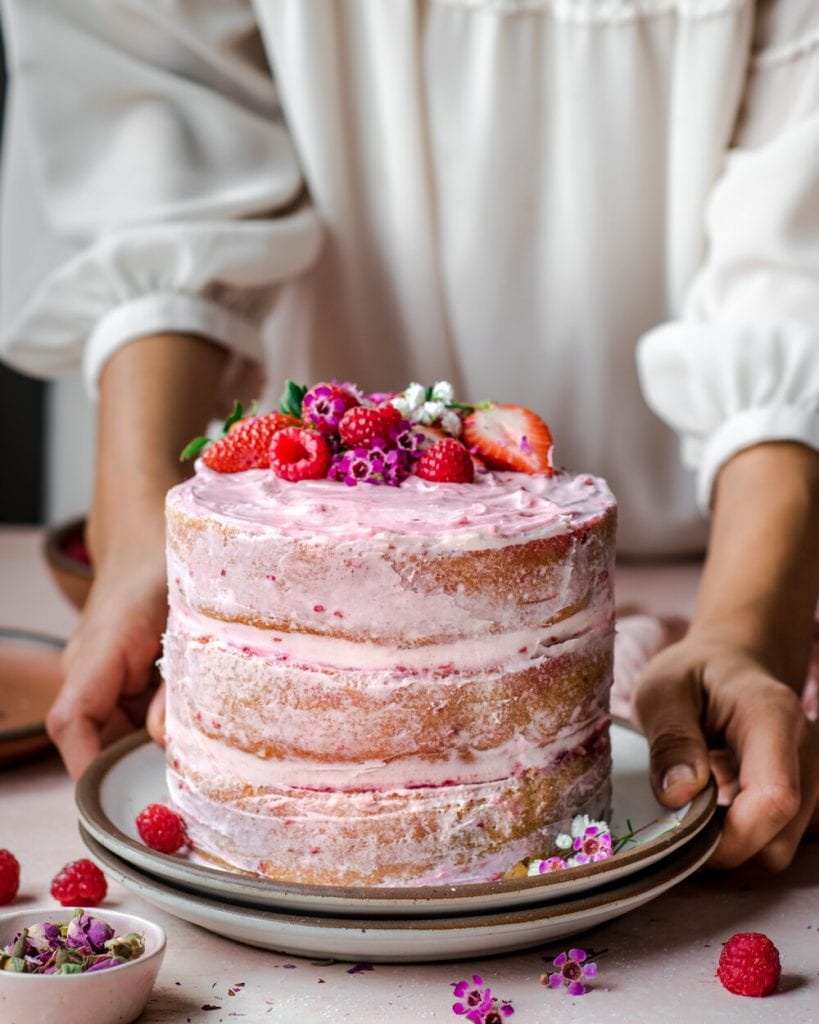
Offset Spatula. This isn’t essential for baking cakes, but it is essential for beautifully frosted cakes. If you don’t care too much about the appearance of the cake, a butter knife will do. But, if you want beautiful frosting waves or want to achieve the “naked cake” look as seen in this recipe, an offset spatula is necessary. It helps smooth and level the tops of the frosting.
When I’m making a smaller cake (as in these 6-inch cakes), I find it more helpful to use a small-sized offset spatula like this.
Bench Scraper. Again, not a necessity, but it is very useful if you want to achieve the “naked cake” look in this recipe. A bench scraper perfectly smooths out the surface of the frosting, including the edges, and ensures that the frosting is evenly distributed (in a thin layer, in the case of a “naked cake”).
If you don’t have a bench scraper, a small or medium straight spatula can also work.
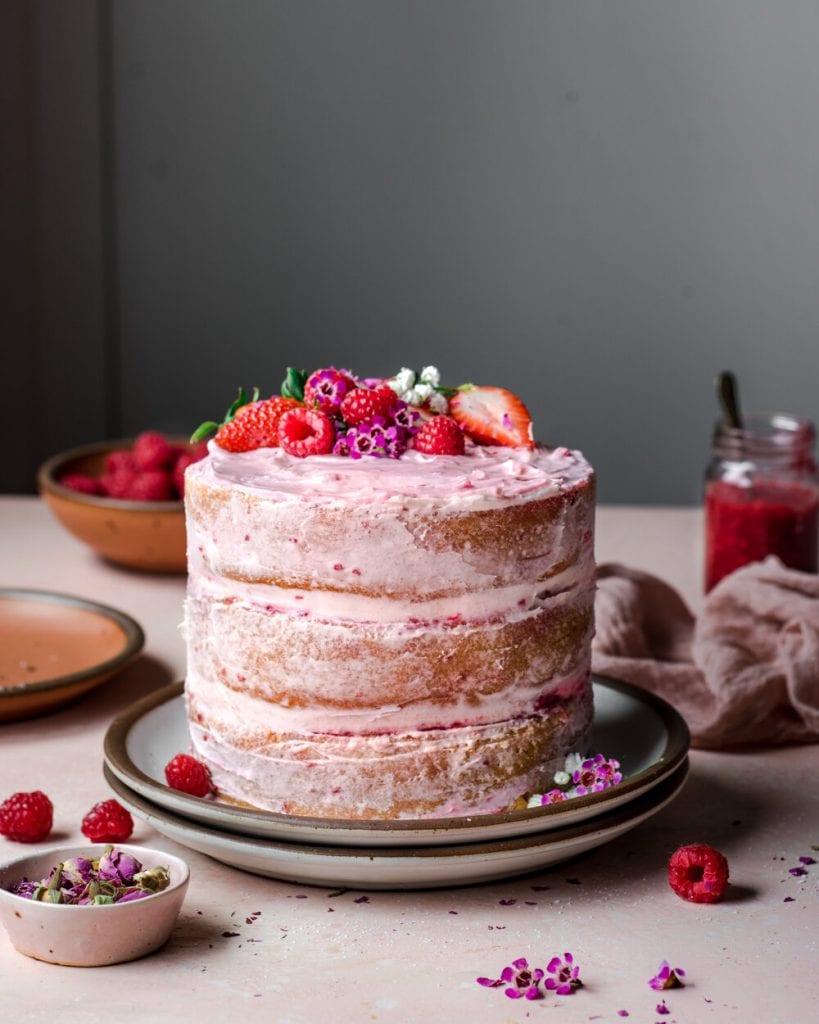
Ingredients in a Vegan Layer Cake
Flour
The type of flour matters. This isn’t a gluten-free cake and I’m not going to pretend I’m an expert on gluten-free cakes, but generally speaking, cakes made with gluten-containing flour are going to be lighter and less dense in texture than than gluten-free cakes.
If you have a gluten allergy, of course, I am not encouraging you to go ahead and test it. But if you can tolerate gluten, use the gluten-containing flour! I promise your taste buds will thank you. That said, if you are allergic or intolerant to gluten and want to make this cake, a 1:1 gluten-free all purpose baking flour is your best bet.
I typically love making cakes with cake flour, as it yields the lightest texture, but I ran out of cake flour and was surprised how perfectly tender this cake came out using all-purpose flour.
Butter vs. Oil
The butter vs. oil debate is a something all bakers face, not just vegan bakers! Oil usually results in more tender baked goods, while butter is more flavorful than oil.
Using an equal mix of oil and vegan butte lends a texture that is light and tender, but also incredibly rich, flavorful, and buttery. So you get the best of both worlds, texture wise. And it’s 100% vegan! I’ve had good success with Country Crock Plant Butter and Earth Balance buttery sticks.
Leaveners
The most commonly used leaveners in vegan baking are baking soda and baking powder, but this cake relies on a third leavener, commonly used in vegan cakes: vegan “buttermilk.” I simply combine plant-based milk with lemon juice and let it rest until it curdles. If you don’t have fresh lemon juice, you can use apple cider vinegar.
As for baking soda and baking powder, this recipe uses a bit of both, and here’s why.
When you use baking soda, it requires a little acid to start reacting. In this case, the acid is the vegan buttermilk (plant milk + lemon juice). It helps activate the leavening action of baking soda, enhancing the amount of rise in your cakes. And finally, the alkaline nature of baking soda (as opposed to the acidic nature of lemon juice) cancels out any sour buttermilk flavor so you don’t end up with an unwanted tangy taste.
But if you want to keep some of that tang flavor (in a subtle way, of course), you’ll want to include some baking powder as well. This is a fruity cake with notes of raspberry and orange, so a subtle tangy flavor is desired. And since using baking soda alone will completely neutralize the vegan buttermilk’s acidity/tanginess, adding baking powder allows some of that tang to remain in the batter.
Egg Substitutes
The type of vegan egg substitute you use should depend on the type of baked good you’re making and your desired texture. For instance, I like to use flax eggs in brownies because it contributes to their fudgy gooeyness.
But with a cake, I want the texture to be airy and light, so I like to rely on aquafaba, which is simply the liquid leftover from cooked chickpeas.
When you lightly whip aquafaba, as is done in this recipe, it turns foamy and light, which then helps to create a light and fluffy texture and gives a nice lift to cakes. This recipe calls for 1/2 cup of aquafaba, and a standard 15.5 ounce can of chickpeas has a little more than 1/2 cup.
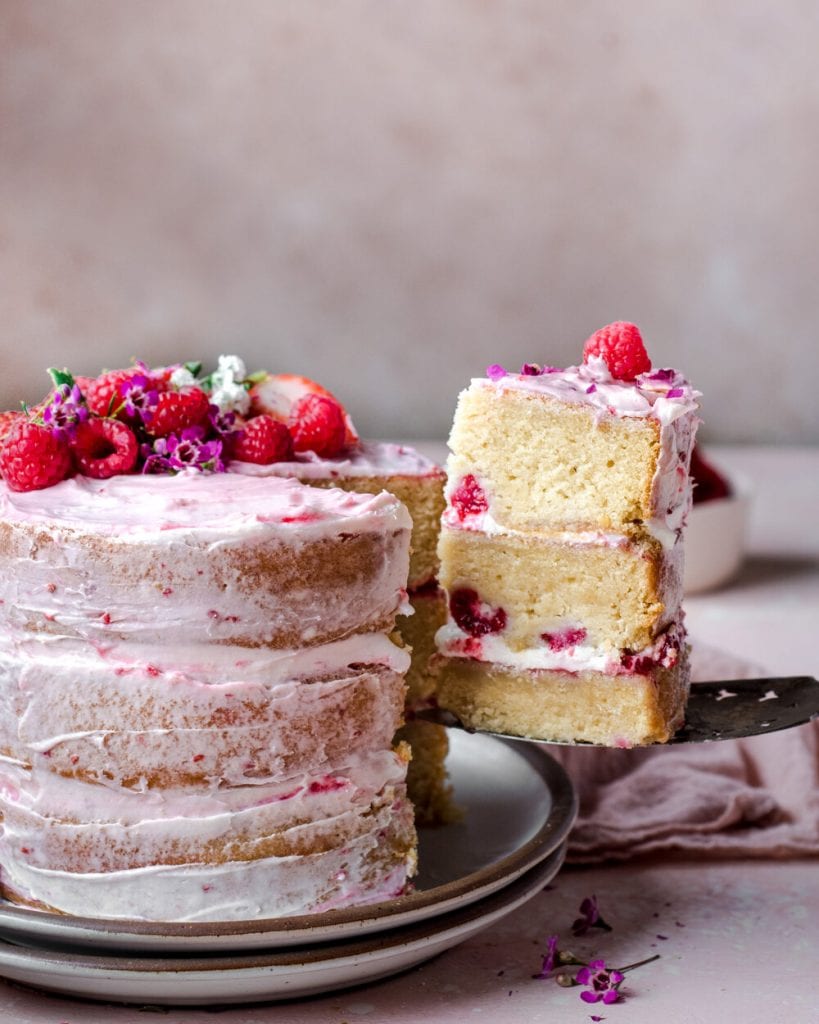
Components in this layer cake
Cake. This recipe uses three 6-inch layer cakes, but you could also make two 8-inch layer cakes.
Frosting. A layer cake needs some sort of frosting or icing, and the Tangy Buttercream Frosting in this recipe is my new favorite frosting recipe. Essentially, it’s a hybrid of a buttercream frosting and a cream cheese frosting, and uses equal parts vegan butter and vegan cream cheese.
I love the subtle but noticeable tanginess that the cream cheese and lemon juice bring to this cake. Unlike many cakes, the flavor does not have a one-note sweetness. If you can’t find vegan cream cheese, substitute the vegan cream cheese with more vegan butter and make a traditional buttercream frosting.
Jam. The homemade Raspberry Jam in this recipe is optional and you can easily make this vegan vanilla layer cake without it. However, it serves three purposes.
First, the jam is a tart, not-very-sweet jam, so again, it’s bringing a nice tart flavor that balances the sweetness of the cake. Two, the jam adds to the cake’s layered elements, making it more interesting texturally and visually. And three, when the jam gets swirled into the frosting, it makes for a beautifully pink cake, as seen in these photos.

How to assemble a layer cake
Refrigerate the cakes
Many bakers will recommend that you refrigerate your layer cakes before frosting, and I find this advice to be especially helpful with vegan cakes, which tend to be a bit stickier and/or delicate than non-vegan cakes.
Adding frosting to a freshly baked cake—which is tender and delicate in texture, even if it has cooled to room temperature—creates friction, making it more likely that the cake will crumble. This isn’t the end of the world, but you will have considerable crumbs in your frosting and it won’t be as pretty.
That’s why I recommend refrigerating your cooled cakes for at least 2 hours, or overnight, before frosting. Wrap them in plastic wrap to keep them moist. But if you’re avoiding plastic (a noble cause), you can put them on plates and cover them with large bowls.
While refrigerating your cakes does add time onto this recipe, it also means that you can bake the cakes in advance. Cakes wrapped in plastic will stay good in your fridge for a few days, so you can do most of the work ahead of time. Or, if you want to make them even further in advance, you can easily wrap the cakes and freeze them.
Refrigerate the frosting
If you are making the Raspberry Jam in this recipe, I recommend refrigerating the frosting for about 30 minutes. If you add a layer of jam to the cake and then dollop room temperature frosting on top, it will be quite difficult to spread the frosting out, as the frosting will want to stay in place. It is not impossible to frost room temperature frosting, but it’s much easier if you refrigerate it for a bit.
So, if you wanted to serve this cake at, say 7 pm, the ideal time to start prepping the frosting would be 5:30 pm.
First, take the vegan butter and vegan cream cheese out of the fridge to soften. This should take around 30 minutes, depending on the temperature of your kitchen. To speed the softening process up, cut both components into small pieces.
Second, make the actual frosting. It takes just 5-10 minutes.
Third, refrigerate the frosting for 30 minutes before assembling the cake.
If you make the frosting well ahead of time, you’ll want to refrigerate it anyways since it’s made with perishable items (vegan butter and cream cheese).
Assemble the “Naked “Cake”
Once your layer cakes have been cooled and your frosting and jam are ready, it’s time to actually assemble the cake! As you’ll see in these photos, I decided to go the naked cake route. A naked cake has a minimal outer layer of frosting, which shows off the cake’s layers and filling.
But this is totally optional. You can frost the cake however you want.
Step 1: Place one layer cake on a cake platter or your serving plate. Spread a thin layer of the Raspberry Jam on top. Then add 1/4 of the Tangy Buttercream Frosting and smooth with an offset spatula.
Step 2: Top with the layer cake #2, and repeat the process, adding more jam and frosting. Finish with layer cake #3, adding jam and frosting on top.
Step 3: Using the offset spatula, apply the remaining buttercream frosting to the sides of each cake layer, starting at the bottom, working your way up to the top. For a naked cake look, you just want a thin layer of frosting.
Step 4: When the sides are covered, use a bench scraper or straight spatula to smooth the sides and to achieve the naked cake look. If you’re not going for the naked cake look, skip this step.
Step 5: Using the offset spatula, smooth out the top layer of frosting until it’s level. You can serve now, or refrigerate for at least 1 hour to set.
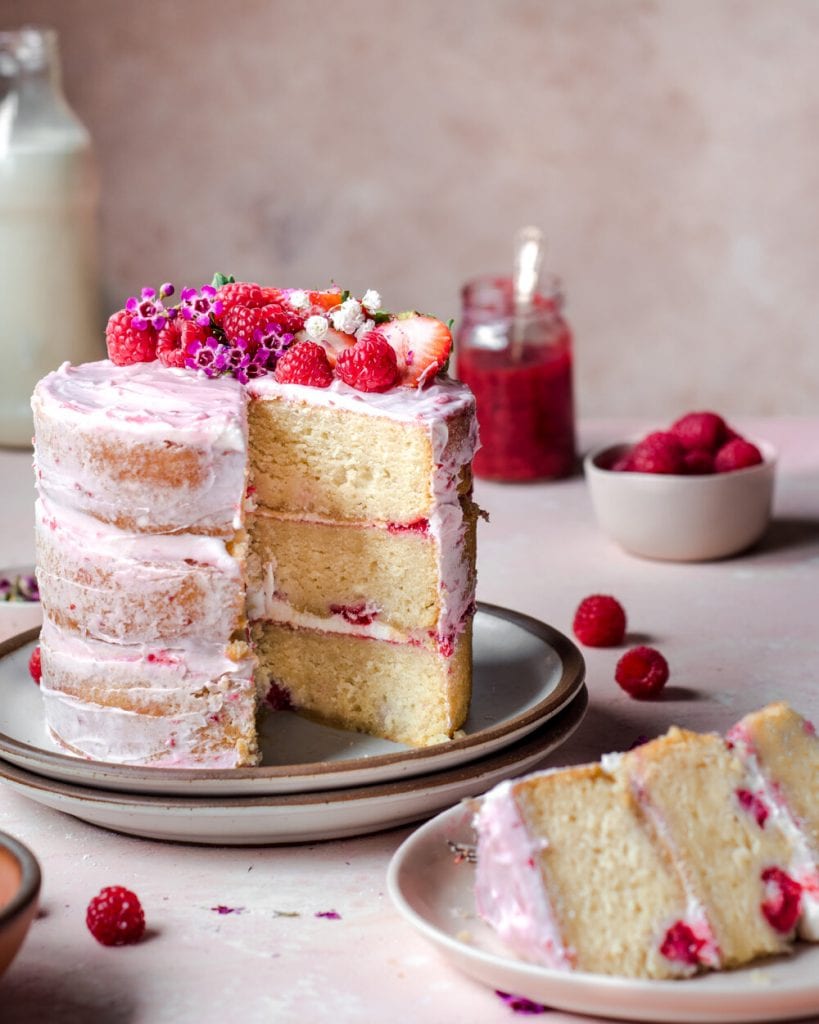
Tips for Baking this Vegan Layer Cake
Whisk the dry ingredients thoroughly
Be sure to whisk the dry ingredients properly before adding them to the wet. This ensures that the baking powder and baking soda are distributed evenly, which will help your cake rise evenly. This is particularly important with layer cakes, where you’re dividing the batter between at least two pans.
Unevenly distributed leaveners can result in cakes that rise unevenly.
Weigh the ingredients
I mentioned this in the “Equipment” section above, but I strongly suggest weighing your ingredients instead of relying on measuring cups. It will yield a more accurate result.
Allow a full “preheat” and use an oven thermometer
Also mentioned above in the “Equipment” section. Before you add your cakes to the oven, be sure that your oven temperature actually reads 350°F according to an oven thermometer. Unless you’ve had your oven calibrated, it’s virtually impossible to tell if the stated temperature on your oven is the actual temperature in the oven.
And if you can, don’t bake the cakes as soon as your oven says it’s done preheating. Many ovens actually take longer to reach the desired temperature than the preheat function says. I like to have my oven on for 30 minutes before baking something as sensitive as a cake.
Cake Pan Conversion: Size and Baking Time
Don’t have three 6-inch pans or two 8-inch pans, but still want to make this cake?
There’s a lot of math here, but to keep things short, if all you have is a 9-inch (23 x 5 cm) round cake pan, your best option is to multiply all the cake ingredients by a factor of 1.5 and use two 9-inch cake pans.
According to this cake pan size guide from Food 52
- a 6 x 2 inch (15 x 5 cm) round cake pan = area of 29 square inches;
- a 9 x 2 inch (23 x 5 cm) round cake pan = area of 64 square inches.
Since we’re making three 6-inch layer cakes, multiple 3 x area of 29 inches = 87 inches.
If you multiply the recipe by a factor of 1.5, it would create enough cake batter for 1.5 x 3 x 29 inches = 130.5 inches. And since two 9-inch round cake pans would hold 2 x 64 inches = 128 inches, it’s almost the exact same amount. Voila!
As for baking time, since a 9-inch pan is bigger and will make the batter more shallow, the center can dry out more quickly. So try increasing the temperature by 25°F to 375°F and decreasing the baking time, to about 25 minutes.
This isn’t a foolproof method so you’ll want to monitor the cake for the typical signs of doneness. In other words, the cake is done when it starts to pull away from the sides of the pan and a toothpick comes out with just a few moist crumbs.

Okay, my brain hurst from all the conversions, so let’s end it here. I hope you enjoy this Vegan Vanilla Layer Cake with Raspberry Jam! If you make it be sure to leave a rating and review below and tag me on Instagram!
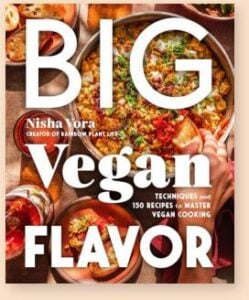
Big Vegan Flavor
Techniques and 150 recipes to master vegan cooking.
Vegan Vanilla Layer Cake with Raspberry Jam
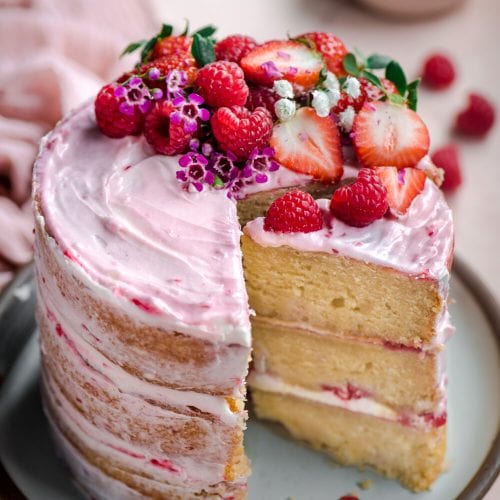
Ingredients
- 1/2 cup (1 stick / 112g) vegan butter, softened at room temperature
- 1 1/4 cups + 2 tablespoons (330 mL) unsweetened plant-based milk (I used this oat milk)
- 1 tablespoon (15 mL) lemon juice
- 1/2 cup (120 mL) aquafaba (the liquid from a can of chickpeas)
- 3 1/2 cups (420g) all-purpose flour
- 1/2 teaspoon baking soda
- 2 teaspoon baking powder
- 1/2 teaspoon fine sea salt
- 1/2 cup (112g) sunflower oil, or melted coconut oil*
- 1 1/4 cups (240g) organic cane sugar
- 1 tablespoon pure vanilla extract
- 2 tablespoons freshly squeezed orange juice (optional)**
- 1 tablespoon orange zest (optional)
- 2 cups (240g) fresh raspberries***
- 1 batch Raspberry Jam (recipe below)
- 1 batch Tangy Buttercream Frosting (recipe below)
Instructions
- Take the vegan butter out of the fridge to soften.
- Make the vegan buttermilk. Combine the plant based milk and lemon juice and stir. Set aside to curdle.
- Preheat the oven to 350°F/175°C. Make three parchment paper rounds for three 6×2-inch (15 x 5 cm) round cake pans and line each pan. Alternatively, you can use two 8-inch (20 x 5 cxm) round pans. Ensure your oven is calibrated or that you’re using an oven thermometer (see notes above in the “equipment needed for baking a vegan layer cake” section).
- Prepare the aquafaba. Pour 1/2 cup of the liquid from a can of chickpeas into a small bowl. With a handheld electric mixer (or stand mixer), beat the aquafaba on medium speed until it‘s foamy throughout, about 60 seconds.
- Whisk together the dry ingredients. Add the flour, salt, baking soda, and baking powder to a medium bowl and whisk well to ensure the leaveners will be evenly distributed throughout the cake.
- Cream the wet ingredients. Add the softened butter, oil, and cane sugar to a large bowl. Using the mixer, beat until the ingredients are well incorporated and starting to get fluffy, 60 seconds or so. Add in the whipped aquafaba, vanilla extract, orange juice (if using), and orange zest (if using). Mix until just combined, 15-20 seconds.
- Add half of the flour mixture into the butter-sugar mixture, beating on low speed until just combined, taking care to not over beat. Then add the vegan buttermilk and beat until just combined. Finally, add in the remaining flour mixture until you have a mostly smooth batter, but do not overmix. It’s okay if there are a few flour pockets remaining. Overbeating can cause the cake to become dense or dry. The batter should be fairly light and fluffy at this point.
- Divide the batter equally in the prepared pans, using a digital scale to measure each pan so each cake is equal in size. The batter in each of my three 6-inch pans ended up weighing 440 grams each. Scatter the raspberries evenly over the top of each cake, but do not press them down.
- Bake 6 x 2 inch (15 x 5 cm) cakes for 30 minutes, or until the center is set and the cake has puffed up a bit and just started to pull away from the pan, and a toothpick inserted comes out with only a few moist crumbs. If you are using two 8 x 2 inch (20 x 5 cm) cakes, bake for 30-35 minutes.Note: I recommend checking 5 minutes before the time is up, as every oven is different and it might be done sooner.
- Cool the cakes in their pans for at least 30 minutes, then carefully invert them onto a cooling rack. Cool completely before adding assembling the cakes.
- Assemble the cakes: If you have the time, I recommend refrigerating the cakes and frosting (see the section above called “Assembly”).a. Place one layer cake on a cake platter or plate. Spread a thin layer of the Raspberry Jam on top. Then add 1/4 of the Tangy Buttercream Frosting and smooth with an offset spatula. Top with the next layer cake. And repeat the process, adding more jam and frosting. Finish with the final layer cake, adding jam and frosting on top.b. Using the offset spatula, apply the remaining buttercream to the sides of each cake layer, starting at the bottom, working your way up to the top. For a naked cake look, you just want a thin layer.c. When the sides are covered, use a bench scraper to smooth the sides and to achieve the naked cake look.d. Using the offset spatula, smooth out the top layer of frosting until it’s level. You can serve now, or refrigerate for 1-2 hours to set the cake.
- Store leftovers in an airtight container in the fridge for a few days.
Notes

Big Vegan Flavor
Techniques and 150 recipes to master vegan cooking.
Raspberry Jam

Ingredients
- 1 1/2 cups fresh raspberries 180g or frozen raspberries (200g)
- 2 1/2 teaspoons cornstarch or arrowroot powder
- 1 1/2 tablespoons cold water
- 1 tablespoon pure maple syrup
- 1 tablespoon freshly squeezed lemon juice
Instructions
- Add the raspberries to a saucepan over medium heat. If using frozen raspberries, stir occasionally until they’re thawed. Mash down the raspberries with a fork.
- Meanwhile, dissolve the cornstarch or arrowroot powder with the cold water to create a slurry.
- Add the slurry, maple syrup, and lemon juice to the pan. Bring to a simmer, stirring constantly, until the jam has thickened. Take off the heat, and once cool, refrigerate. It will thicken even more as it rests in the fridge.
Notes

Big Vegan Flavor
Techniques and 150 recipes to master vegan cooking.
Tangy Buttercream Frosting

Ingredients
- 1/2 cup (1 stick / 112g) vegan butter, softened at room temperature
- 4 ounces (113g) vegan cream cheese, softened at room temperature*
- 2 1/4 cups (~ 265g) organic powdered sugar, sifted
- 1 teaspoon pure vanilla extract
- Pinch of sea salt
- 1 tablespoon fresh lemon juice
Instructions
- To a large mixing bowl, add the softened vegan butter. Beat on low speed with an electric handheld mixer (or stand mixer) until smooth and fluffy. Add the vegan cream cheese and beat until creamy and smooth and well incorporated.
- Gradually add the sifted powdered sugar in four turns, and mix on low speed until well combined and fluffy, scraping down the sides. Add the vanilla, salt, and lemon juice and beat until smooth. If the frosting is too thick, add a tablespoon of plant milk until you reach your desired consistency. Refrigerate for at least 30 minutes to make it easier to frost the cake.
Notes
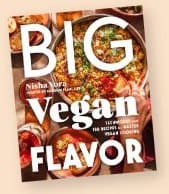



I am in process with this beautiful looking cake….and about to refrigerate the cakes for assembly tomorrow….when assembling, I assume the present top of the cake then goes on the bottom…in other words, I am putting the jam/frosting on the cake which does not have raspberries embedded in it?? Perhaps it doesn’t matter but….smells heavenly so far!
Hi Elaine, sorry we didn’t get back to you in time! How’d it go?
This cake was amazing! I made it for an Easter celebration and everyone raved about it, vegans and non-vegans alike! So worth the effort and I’m sure it will get easier each time I make it and I will definitely be making it again and again! It also looked beautiful (wish I could show you a picture)! I did have to bake the layers longer than 30 minutes, but I know my oven temp is off. Thank you for a wonderful recipe! It’s definitely a keeper!
We are so happy everyone loved the cake, Tricia :) Thank you for taking the time to share your thoughts and for trying out the recipe!
Love this! So good, but definitely needed to cook way longer than expected, though that may have been my oven. Definitely recommend!
Also I am using this buttercream recipient for everything from so on, so delicious 🤤😋
Thanks for the sweet comment, Rylee! And we definitely recommend getting an oven thermometer for future baking! :)
I have insulin resistance, and I want to try your recipe.
Can I use coconut sugar instead of organic cane sugar?
Hi Paola, coconut sugar has less moisture than cane sugar so the cake might end up a bit drier. Cane sugar or white sugar adds sweetness but also moisture and structure, so, in this quantity, you will notice a difference with coconut sugar. That said, if you are familiar with baking with coconut sugar, you can try it out for yourself.
I made it with coconut sugar yesterday and the cake turned out absolutely amazing! Only thing is that the frosting turns a tanish color and its harder to achieve the pink color. I just packed on a bunch of strawberries and rasberries on top for a colorful look! And sifted the coconut sugar for the frosting too and that worked great . I will also try date sugar in the future since that’s closer to white!
I also used avocado oil since I didn’t have the oils asked for the recipe and that worked great as well! I also used 2 eggs instead of aquafaba since I can have eggs!
Good to hear, Sandie! Thanks for sharing :)
This looks amazing. I am planning to make this for my son’s second birthday. I am thinking to make the jam with blueberries instead of raspberries. Would that be ok? Thanks! :)
Hi Szilvi, that should work fine! They have pretty similar water content so it shouldn’t be a problem. I might use a touch less maple syrup in the jam and a touch more lemon juice since raspberries are tarter than blueberries.
This cake is turning out just fine in the oven now. But I have a question on step 6 for the cake batter: What specifically is “the liquid ingredients”? I had several ready on the counter and took a guess- wrong.
I love your recipes!!!
Hi Karen, we hope you loved the cake :)
As for the wet ingredients, you can see what we mean by the first words in step 6 of the recipe card: “Cream the wet ingredients. Add the softened butter, oil, and cane sugar to a large bowl. Using the mixer, beat until the ingredients are well incorporated and starting to get fluffy, 60 seconds or so. Add in the whipped aquafaba, vanilla extract, orange juice (if using), and orange zest (if using). Mix until just combined, 15-20 seconds.”
Hello, I made this cake and followed your recipe. I did use gf flour, but for some reason the cake batter curdled as soon as I added the milk, it was absolutely fine until this point. Can you suggest anything that may have caused this?
Hi Frankie, gluten-free flour is very different from all-purpose (wheat-based flour), especially in egg-free baking. I always indicate whether a baking recipe can be made gluten-free in the notes and if we’ve tested it because it’s often a difficult swap that requires other adjustments to the recipe. Curdling usually happens when you mix soy milk (or another high-protein milk) with an acidic ingredient such as lemon juice or vinegar. Did you use soy milk as your plant-based milk? It’s possible (though I’m not sure) that the protein in soy milk interacted with some sort of ingredient in the gluten-free flour.
Did you end up baking the cake, and if so, how did it turn out?
Once again, Nisha killed it with this recipe. I made it for mom’s birthday and my family went crazy over it. I substituted strawberries for the raspberries. So delicious!
Your positive feedback is the best reward for our hard work. So lovely to hear the cake was a hit with the family! Thank you, Jane!
This cake is amazing. I made it for a friend’s birthday and everyone LOVED LOVED LOVED. It it still talked about one year later! I am making it again this week for another friend. Make this cake!!! 🎂😋
I agree, Cherie! This cake is amazing!! I had my mom make it for my birthday last year. So happy to hear you loved it too :)
I just made this cake and it turned out AMAZING!! I wanted to make mango cake so I substituted the plant-based milk with fresh mango puree, half of the flour with whole wheat flour, and reduced the sugar to 3/4th the quantity. One of the best cakes I’ve had! Thanks for the amazing recipes Nisha and Rainbow Plant Life team <3
Thank you for sharing your substitutions, Ankita! It’s lovely to hear the layer cake was such a success despite all the substitutions.
My family enjoyed the cake . Only concern is while baking the layers rose but later fell flat. May I know how that can be prevented . With heartfelt thanks —Anjana Bora
Hi Anjana, so sorry to hear your cake fell flat :/
Cakes often fall flat because they are underbaked, so be sure to insert a toothpick in the center to ensure it’s entirely baked through–either no crumbs or just a small amount of cake crumbs that aren’t wet. Also, look at the edges of the cake–if the cake has pulled away from the pan a bit, that’s a good sign it’s done. If the center feels soft or loose, you need to bake a little longer.
Another possible culprit is the baking powder or soda. It’s possible a bit too much was added, which can result in cakes that expand quickly but then sink.
A few other things you can check or change for next time: use an oven thermometer (often our ovens are cooler or hotter than they say, which can lead to underbaked or overbaked cakes); don’t open the oven during baking, as it lets out heat and can cause the cake to take longer to bake; make sure to cool the individual layers (not stacked) on cooling racks on the counter for minimum 30 minutes (maybe longer).
Finally, this in-depth article might have more helpful information.
We hope you’re able to figure out what went wrong!
Absolutely delicious.
We’re thrilled you think so, Katie! :)
My go to Birthday cake every year! Thank you so much for this recipe
How long with the raspberry jam stay in the fridge?
So nice to hear that, Monisha :) It should stay good for about 1 week.
This cake looks delicious! Is the aquafaba from a regular can of chickpeas OK? (Not low sodium) Wondering if this will make the cake too salty? Alternatively, if we don’t have canned chickpeas will egg whites be an OK sub for the aquafaba if we aren’t vegan? Thank you!
Hi Nirmal, yes that will be fine! You can use a scant 1/2 tsp sea salt in the dry ingredients just to ensure it’s not overly salty. As for egg whites, I can’t say I know how to convert to egg whites since I’m vegan and haven’t baked with eggs in 7+ years. Hope you will enjoy the cake!
2 eggs worked great as a sub for aquafaba! Everyone is still raving about this cake I made for my sister’s birthday!!
I made this cake and it was a BIG HIT! It was so pretty and even more delicious. Everyone demolished it and I am making it again tonight! It made me look like I knew what I was doing! LOL. I am NOT an expert baker by any means. This is a keeper! I used less sugar (1/4c less) because I prefer things not so sweet and it was great.
Awesome, Laura. Thanks for your comment and for taking the time to review!
I’ve made this cake twice now, and I adore it. It will certainly be my go-to cake recipe from here on out. It satisfies a particular cake craving that many vegan cakes miss the mark on. Well done!
Thanks for your sweet comment, Nicole! I just tried this recipe for the first time myself, my mom made it for me for my birthday, and I was also very impressed!
Cake was a little dense, but loved the frosting and the jam. Followed the recipe exactly.
Hi Zara, sorry to hear you found it too dense.
A dense sunken cake could have been caused by a variety of factors,
A few things you can check or change for next time: use an oven thermometer (often our ovens are hotter or cooler than they say) which can help with over and under baking, don’t open the oven during baking which lets out heat (you can view the cake with the oven light through the door), and make sure that you’re not over-mixing your batter. Over-mixing can cause the gluten in the flour to develop too much, which can lead to a denser, gummy texture in the bread as well as sinking in the middle. You want to mix the dry and wet ingredients together just until combined.
We hope you’re able to troubleshoot this issue and get the cake perfect next time!